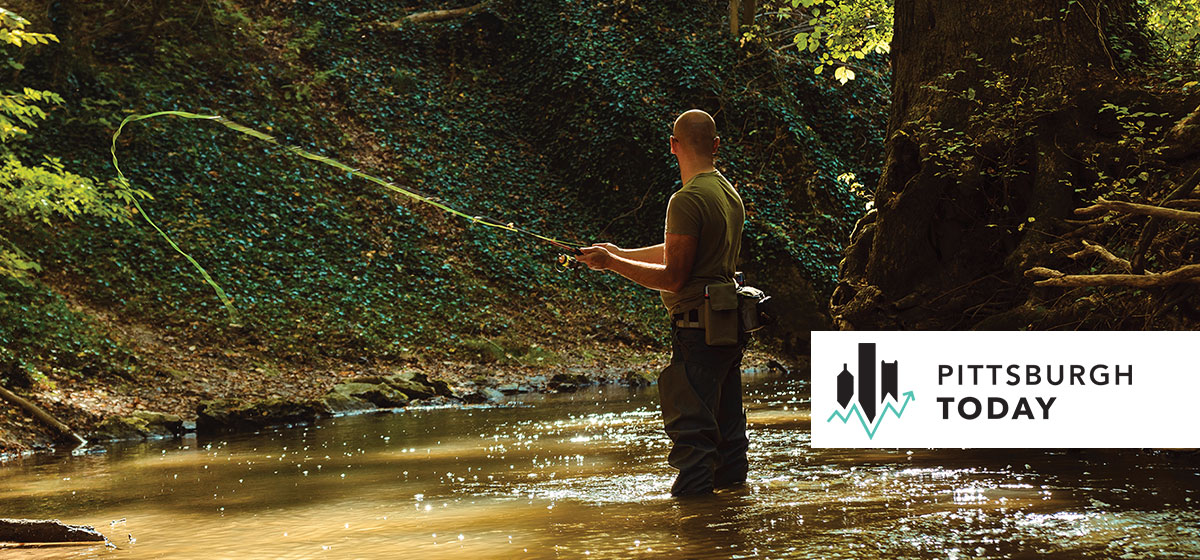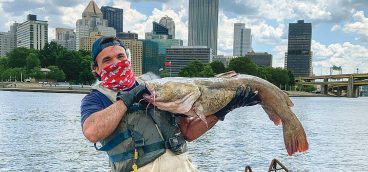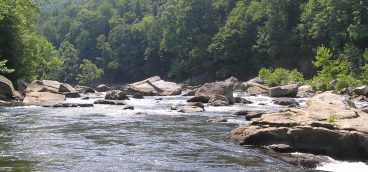The Perfect Antidote

Bob Phillips was in Chile fly fishing with a group of clients in early March of last year. For 10 days, he’d been in places that the news of the world didn’t reach. It wasn’t until he boarded the plane for home that he knew something wasn’t right. “Everyone was wearing masks,” he said. “What’s going on?”
The COVID-19 pandemic had reached southwestern Pennsylvania in his absence. Businesses were shutting down when he returned. At International Angler, a fly-fishing outfitter in Robinson where he is general manager, a scheduled trip to the Bahamas fell apart as customers canceled. Trips to western U.S. trout streams, Cuba and other fly-fishing destinations followed suit.
Phillips closed the shop and kept the doors shut through April and May, the peak season for fly shops in the eastern U.S.
What happened next, however, was unexpected. He reopened in June after the number of new COVID cases in the region slowed to a trickle. When he did, “It was bonkers. Everyone wanted to go fishing,” he said. “I couldn’t keep up. We didn’t totally make up for what we lost in the early months, but we did really well. And it’s still going hard.”
In fact, business at the shop is so good this year that replacing inventory is a challenge as manufacturers of waders, fly rods and other gear struggle to keep up with demand. A trip to the Big Horn River in Montana sold out the day the shop announced it.
And it’s not only fly-fishing gear for which pandemic-weary Americans are clamoring. Bicycle sales were up 52 percent last year. Sales of kayaks, stand-up paddle boards and canoes, golf equipment, tents and other camping equipment, and binoculars and other gear related to bird watching and viewing nature all saw double-digit growth last year, according to NPD Group, a market research firm.
“This is unprecedented,” said Matt Powell, NPD senior sports industry advisor. “You think about all of the pain and suffering we’ve been through, and yet, parts of this business are off-the-wall good.”
The outdoors beckons
If there’s a silver lining to the pandemic, the outdoor recreation industry has found it. Americans have turned to the outdoors for relief from screen-time overload, social lives cramped by limits on gatherings and other pandemic impositions that test their sanity.
In a national Harris poll, 69 percent of Americans said they acquired an increased appreciation of the experience of being outdoors after the early pandemic lockdowns were lifted. Sixty-five percent said they now seek outdoor activities to occupy their time.
The desire to get out of the house, get some exercise, stay healthy, connect with nature and manage stress were among the top reasons Americans resumed or started an outdoor activity during the pandemic, according to a recent Outdoors Industry Association survey. Walking, running, bicycling, birdwatching and fishing attracted the most newcomers.
Pennsylvania’s state parks drew 45 million visitors last year — 8 million more than in 2019, despite being closed to camping early during the pandemic.
Some 86 percent of visitors said the time they spent in state parks and forests was essential to their mental and physical health during the pandemic, a Department of Conservation and Natural Resources survey suggests. One out of five of those visitors bought outdoor recreation equipment and apparel last year and 37 percent of those who did spent $250 or more.
Outdoor recreation accounted for 1.6 percent of Pennsylvania’s gross domestic product in 2019, according to the U.S. Bureau of Economic Analysis.
The public health crisis may have been a wake-up call for many Americans that could have a lasting impact on how they see outdoor recreation, Powell said. “I think people are going to remain interested in staying fit, being healthy and getting outside.”
Sales data also suggest the pandemic drove many Americans to try certain outdoor activities for the first time. Tents, for example, sold well last year. But the big demand was for recreational tents popular among campers who prefer to pitch them in backyards or use them to go car-camping in state parks. Sales were less robust for the more technical tents that experienced campers favor when hiking deep into the backcountry far from flush toilets and bathhouses.
By exposing droves of Americans to new activities, the pandemic appears to have given outdoor recreation businesses a rich opportunity to strengthen their customer base for years to come. The Outdoor Industry Association survey found that more than 60 percent of those who took up bicycling, walking, running and fishing during the pandemic don’t intend to quit when the crisis ends.
In the riffles
America’s streams and rivers check all the boxes as places where respite from coronavirus and quarantine can be found.
More Pennsylvanians realized that last year. Sales of fishing licenses jumped 15 percent, reversing years of declining interest. Local outfitters felt it in sales and foot traffic.
A mid-week morning early this spring found a knot of a dozen or more anglers fishing the narrow run on Neshannock Creek that flows behind the Neshannock Creek Fly Shop in Volant, a quiet Lawrence County village surrounded by Old Order Amish farm country.
“It’s like the first day of trout season every day,” said owner Matt Collier, who bought the shop 10 months before the pandemic. “We’re seeing everyone from longtime fly fishermen who have more time to fish, to some who’d gotten away from the sport and now have come back, to a lot of people new to it.”
Most heartening, he said, was a noticeable increase in the number of young anglers, whose waning numbers statewide had long been a reason for concern. “It was unbelievable seeing all the young kids out there.”
The surge of interest is being seen throughout the country. For some trout fishing destinations, the crush of visitors during the pandemic has been an issue. Montana’s Madison River was so congested last year that the state’s Department of Fish, Wildlife and Parks imposed a cap on fishing and rafting trips and other crowd-control measures.
Pennsylvania has avoided such problems. In most cases, when more people than usual turn up at a stream, anyone willing to hike 100 yards can find solitude in the bosom of nature. That’s even true of the state’s most renowned trout streams.
Joe DeVita is willing to drive 120 miles or more from his Oakmont home to catch wild brown trout with a fly rod on central Pennsylvania’s limestone-influenced streams. He traveled to the Little Juniata River in Huntingdon County one Saturday morning in early April when the Eastern Redbud trees were in blossom.
Blossoming redbuds signal to anglers that the stream’s prolific hatch of grannom caddis flies is near. Fly fishing, in particular, demands a working knowledge of the species and behavior of the aquatic insects on which trout feed. Word of the pending grannom hatch attracts anglers from across Pennsylvania and nearby states each year. Yet, DeVita had no trouble finding a stretch of the 32-mile stream where wildlife was abundant and humans were scarce.
Chirping birds and whispering riffles evoked a natural state of calm on the stream throughout the day that was occasionally broken by the rumble and squeal of a long, slow train passing through the valley. DeVita stood in knee-deep water. The waders and boots he wore and the fly rod he used were made in Montana, but bought at International Angler in Robinson. He made a cast to a lazy pool, anticipating the strike of a brown trout he hoped to fool with a nymph fly made by a friend, who had tied it with feathers, hook, tungsten bead and thread bought at a local fly shop.
“I love it,” he said of the sport he took up 12 years ago. “It’s challenging. There’s a little science involved. And it takes you to absolutely beautiful places.”





